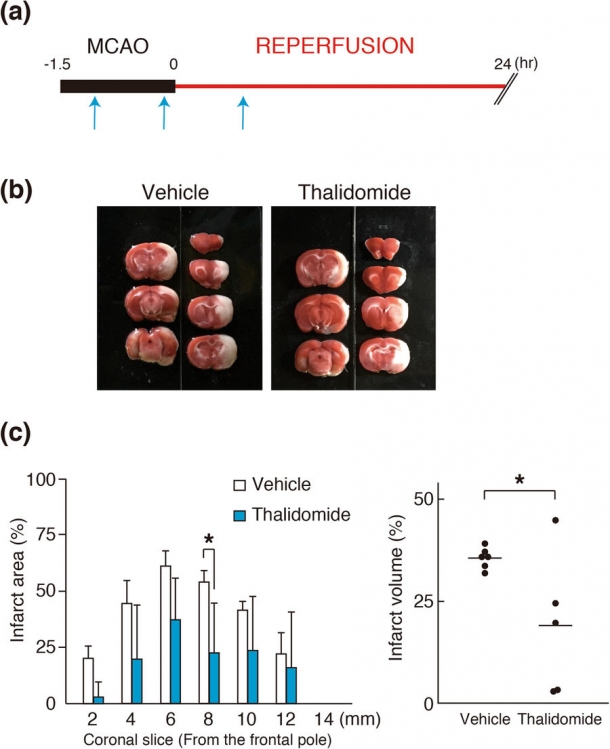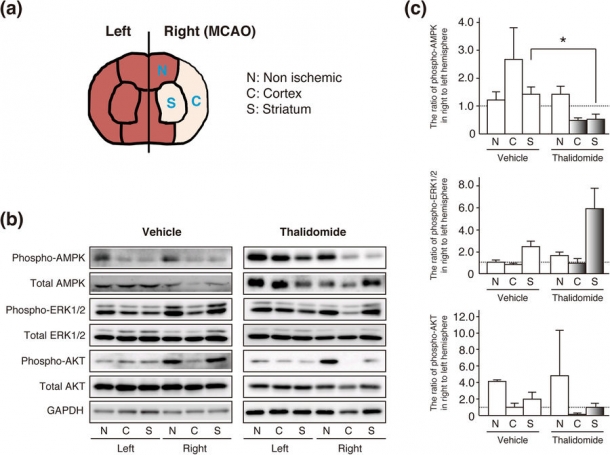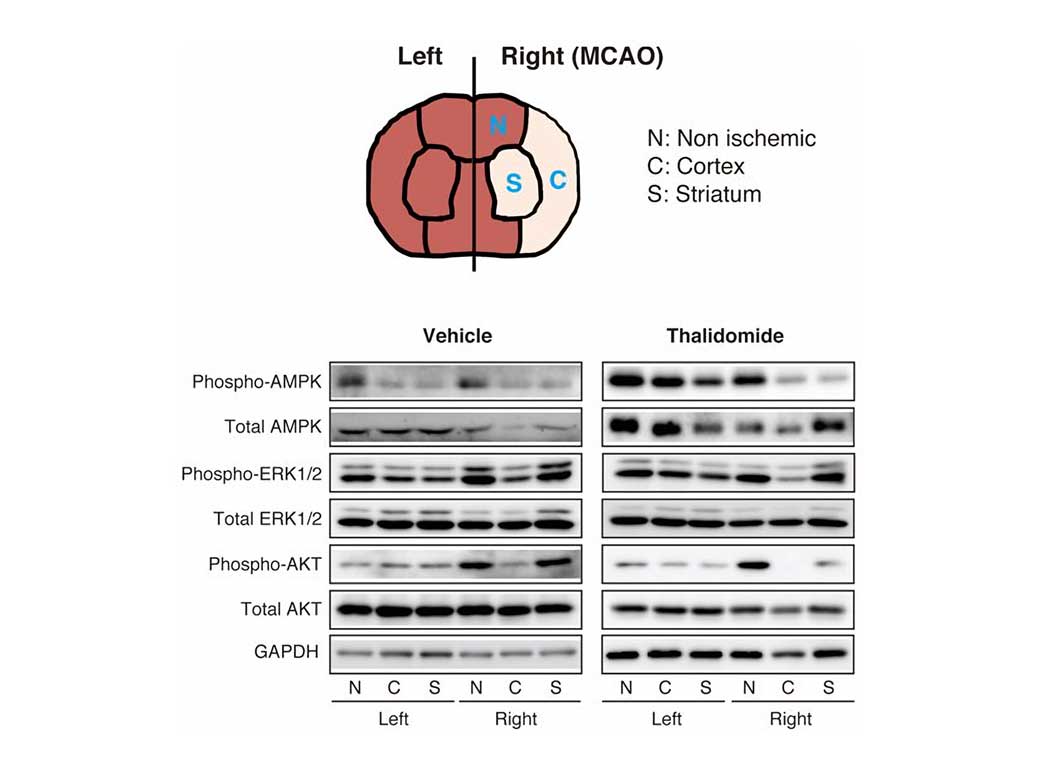How thalidomide is effective against cerebral infarction
Tue, Mar 6, 2018-
Tags
Scientists reveal that this dangerous drug could suppress nerve cell death

The effect of thalidomide on infarct volume of the MCAO/R model. (Scientific Reports 8, Article number: 2459, Figure No. 1bc, 6 February 2018 © Macmillan Publishers Limited.)
Notoriously remembered as a major pharmaceutical scandal approximately 60 years ago, thalidomide caused severe birth defects since many pregnant women took the drug as a remedy for their morning sickness. In recent years, however, thalidomide and its derivatives have been widely used to treat hematologic malignancies such as multiple myeloma.
Evidence also suggests that thalidomide has a neuroprotective effect, reducing both oxidative stress and inflammatory response, but the exact molecular mechanisms of thalidomide on the brain were unknown.
To investigate, scientists at Waseda University and Tokyo University of Pharmacy and Life Sciences studied thalidomide’s target protein, cereblon (CRBN), and its binding protein, AMP-activated protein kinase (AMPK), which plays an important role in maintaining intracellular energy homeostasis in the brain. Through their study, they revealed that thalidomide inhibits the activity of AMPK via CRBN under oxidative stress and suppresses nerve cell death.
“We hope that our findings will help with the development of new and safer thalidomide derivatives,” says Naoya Sawamura, associate professor of neuropharmacology at Waseda University and leading author of this study, “to better treat diseases such as cerebral infarction, a type of stroke which is a major cause of death worldwide.”
Their study was published online in Scientific Reports on February 6, 2018.
Specifically, Sawamura’s research group used cerebral ischemia model rats of the cerebral artery occlusion/reperfusion (MCAO/R) to examine the effect of thalidomide on infarct lesions caused by cerebral ischemia and related intracellular signals. After performing qualitative analysis and assessments on the rats’ physical movements, they found that thalidomide treatment significantly decreased the infarct volume and neurological deficits in MCAO/R model rats, and that AMPK was the key signaling protein in the mechanism through additional experiments.
Moreover, to determine the molecular mechanisms of the effect of thalidomide on neuronal death, they used oxidative stress-induced neuronal cells, which were induced by administration of H2O2, as cerebral ischemia model cells. “In these cells, we found that the AMPK-CRBN interaction weakened and phosphorylation of AMPK enhanced, but thalidomide treatment restored the AMPK-CRBN interaction and suppressed phosphorylation of AMPK,” explains Sawamura. “What this implies is that thalidomide regulates AMPK-CRBN interactions in cells under ischemic conditions, meaning, it can suppress nerve cell death.”

The effect of thalidomide on neuroprotective signalling molecules in the MCAO/R model. (Scientific Reports 8, Article number: 2459, Figure No. 3ab, 6 February 2018. © Macmillan Publishers Limited.)
Further study is needed to identify effective thalidomide derivatives with fewer side effects, as well as more stability because they undergo hydrolysis spontaneously and rapidly in aqueous solutions. Nevertheless, Sawamura is excited about the future possibilities of this study.
“Our attention is now on the functions of CRBN as a stress response molecule. The suppression of nerve cell death by thalidomide perhaps occurs because CRBN’s function as a stress molecule is somehow enhanced. We want to elucidate the response of cereblons in aging and stress models to see if decline in the CRBN function could be a biomarker for aging and stress.”
About the article
- The Neuroprotective Effect of Thalidomide against Ischemia through the Cereblon-mediated Repression of AMPK Activity
- Published in Scientific Reports on February 6, 2018
- Authors: Naoya Sawamura*1, Mariko Yamada1, Miku Fujisawa1, Haruka Yamada1, Hideki Hayashi2, Norio Takagi2, and Toru Asahi1
1) Waseda University, Tokyo, JAPAN
2) Tokyo University of Pharmacy and Life Sciences, Tokyo, JAPAN
*Corresponding author: [email protected] - DOI: 10.1038/s41598-018-20911-2














